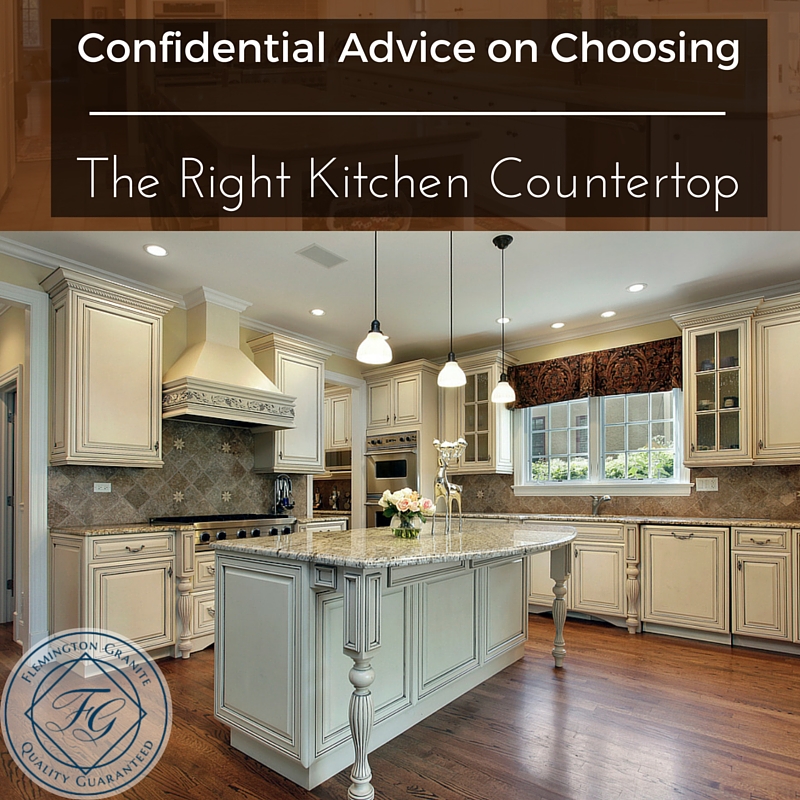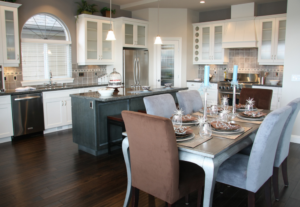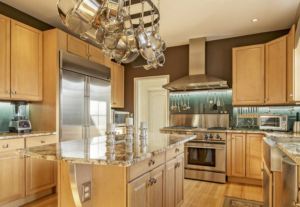
When you are preparing to renovate your kitchen, you’re likely trying to decide how you will choose the best countertop option to fit your design scheme as well as your budget. When you are wise in choosing the right kitchen countertop, it can add additional beauty with sparkle, texture or color. The best choices will also be very strong, withstanding sharp knives, high temperatures, stains and every other abuse.
There are many different surface choices for your countertops, including a variety of different stones and styles. Each material has its individual pros and cons. Here is a brief primer on some of the most popular options so that you have a better understanding of what’s available.
Slabs
When you choose natural stone for your countertops, they come in 5-foot by 8-foot slabs that range in thickness from 3/4 inches to 1-1/4 inches. Every slab is unique, so you will want to go to the showroom in person to pick the one that is your favorite. You shouldn’t rely on small sample pieces, as they won’t give you a true idea of how your countertops will look. Make sure that the stone provider records your chosen slab number on your receipt and tags the slab as well. It is also smart to take a photograph of yourself standing with your slab so that you can prove which slab you bought if the wrong one is delivered to you.
The profile of the countertop edge
Choosing your slab is only the first step. You’ll next need to decide what type of profile you want for the edges. These profiles are the finishing touches that can make your countertops unique. For a modern feel, you can choose a simple edge. If you are wanting a more classical look, you can instead choose an edge profile that is intricate.
Keep in mind that the more intricate the edge is that you choose, the more expensive it will be and the more difficult to clean. Kitchen debris tends to build up in the swirls and cavities in decorative edge profiles. Here are some popular types of countertop edges:
- Waterfall edge profile – This edge profile style has multiple rounded portions that appear to form a cascading waterfall, making it very ornate and a bit difficult to clean.
- Ogee edge profile – This edge profile has an S-shaped curve, giving your kitchen an elegant feel.
- Full bullnose profile – With a rounded edge, countertops finished with this profile have a fluid appearance that is also easy to clean.
- Quarter-round edge profile – Countertops with this type of edge profile have a slight curve that makes them appear extra thick. This is a great option for both bathrooms and kitchens because water can fall over the edge instead of pooling on the counter.
- Straight edge profile – This edge profile gives a thoroughly modern look with its no-nonsense lines and polished finish.
Countertop overhang
The overhang of your countertops is the part that extends beyond the cabinets underneath by about 1 to 1.5 inches. The purpose of your overhang is to keep spilled substances from dripping down onto the fronts of your cabinets or into your drawers.
On kitchen islands, people often choose to have overhangs that protrude out about a foot from the cabinets below so people have room to pull up stools. If you choose to extend them out even further, you’ll need to add supports.
Granite countertops
Granite has long been a favorite among both homeowners and builders. Granite is an extremely hard and durable natural stone that resists scratching and heat. Every slab is unique, and granite comes in a broad array of colors. If you choose granite, you should expect to pay between $60 and $100 per square foot.
Soapstone countertops
Soapstone is a beautiful black or gray stone that is mined in the Appalachians. This natural stone is primarily formed out of talc, which gives the stone a soft feel with white veins. It’s easy to shape and to cut because it is softer than most other natural stone and engineered stone choices. Unfortunately, its soft nature also makes it more susceptible to chipping. You should expect to pay between $50 and $100 per square foot for this natural stone choice.
Caesarstone countertops
An engineered stone countertop material, Caesarstone is manufactured. Made up of crushed quartz and tough resin, it resists both scratches and stains, making it one of the most durable choices. It does not have the natural beauty of marble or granite since it is manmade. It is less expensive, however, and you should expect to pay around $40 per square foot to have it installed in your home.
Laminate countertops
The primary benefit of laminate countertops is that they are cheap, costing somewhere between $10 to $40 per square foot. Laminate is made out of resin and paper that are bonded together using pressure and high temperatures. Since they are easy to scratch and cut, they can start looking bad fairly quickly. For that reason, if you go with this for your countertops, make certain to always use cutting boards when you cook.
Corian countertops
Dupont offers Corian countertops, a popular brand that is manufactured from a blend of polyester and acrylic. It appears warmer than natural stone and is available in a broad variety of colors that you can’t find in nature. The seams are invisible, allowing you to have a large, smooth area. You can expect to pay around $40 per square foot for Corian.
Sealing your countertops
If you choose natural stone countertops, you will need to have the professionally sealed on a periodic basis. This is because natural stones are porous, meaning that grease, wine and food can stain them over time. The lighter the shade you choose, the more porous the stone is. This means that very light shades should be sealed every quarter to once a year. If you seal them yourself, you’ll need to open your windows because of the fumes of the sealant.
Sink reveal
Your sink reveal is the hole that will accommodate sinks that are under-mounted beneath your counter. The bigger it is, the more edge will show. Positive reveals are ones in which the rim of the sink is exposed by about 1/8 inch around the opening. This option allows you to show off your sink. If you choose a zero reveal style, you will instead line up your sink with the edges for a flush appearance. Finally, a negative reveal is when you choose to extend your countertop over the edge of the sink, which gives off a modern and contemporary appearance.
For more ideas about choosing the right kitchen countertop material and to see what Flemington Granite has to offer, we invite you to stop by our showroom to take a tour and see the slabs we have available. We also have professional designers who will be happy to talk about how the various design trends will work in your home and give you ideas for creating a beautiful kitchen or bathroom. You can also fill in your contact information in our contact form or call us today for more information.






